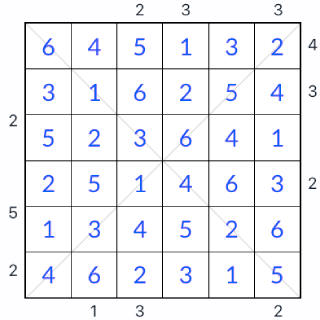Diagonal Consecutive Sudoku Medium
Like this puzzle!
6
7
9
5
4
1
6
9
8
1
7
6
9
4
7
9
1
4
2
1
3
5
2
4
9
3
5
2
9
6
8
5
1
4
1
2
3
4
5
6
7
8
9
?
~
123
1
2
3
Helping solve
Undo
Redo
Delete
0
Hint
Latest score list for #v0rpz
me
medical a second ago
3'56''
an
anonymous 14 minutes ago
10'12''
gu
guest 25 minutes ago
5'31''
br
brother 12 minutes ago
6'38''
sa
sandwich 31 minutes ago
9'18''
me
medical an hour ago
16'7''
gu
guest an hour ago
5'56''
de
degree 33 minutes ago
10'37''
fi
fishing 51 minutes ago
19'11''
Ur
Urgent 37 minutes ago
8'20''
Latest score list for Diagonal Consecutive Sudoku
la
lawyer solved puzzle No#g4rx1;
17'55''
re
repair solved puzzle No#jej7e;
8'46''
La
Lawyer solved puzzle No#g4rx1;
18'41''
br
brother solved puzzle No#7jjm1;
16'9''
ma
magento solved puzzle No#7pgr4;
8'59''
Mi
Mia solved puzzle No#8w725;
14'33''
gu
guest solved puzzle No#pnkvv;
15'38''
an
anonymous solved puzzle No#pnvdr;
12'21''
an
anonymous solved puzzle No#mnryq;
11'8''
da
damage solved puzzle No#7j6nk;
12'44''
How to play Diagonal Consecutive Sudoku
Diagonal Consecutive Sudoku Rules
Consecutive Sudoku: Standard Sudoku rules apply (1-9 in each row, column, and box) with the added twist of bars between some squares. These bars mean the numbers in those squares must be consecutive (differ by 1).
Diagonal Consecutive Sudoku Additional Rules:
-
Diagonal Sudoku Rule: Sudoku main diagonals also contain the digits 1 through 9.
Read more: Diagonal Consecutive Sudoku rule & tips
Using the Markings:
Pay close attention to the consecutive markers while placing numbers. If two cells are connected by a bar, the numbers you place in them must differ by exactly 1.
Conversely, if there's no marking between two cells, the numbers in those cells cannot be consecutive.
Diagonal Consecutive Sudoku = Diagonal Sudoku + Consecutive Sudoku.
Privacy Policy Copyright Gridpuzzle © 2024


























